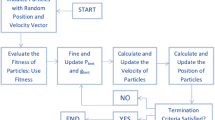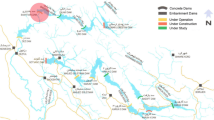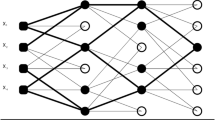Abstract
Blasting operation is an inseparable operation of the rock fragmentation process in the surface mines and tunneling projects. Ground vibration is one of the most undesirable effects induced by blasting operation which can cause damage to the surrounding residents and structures. So, the ability to make precise predictions of ground vibration is very important to reduce the environmental side effects caused by mine blasting. The aim of this paper is to develop a simple, accurate, and applicable model based on particle swarm optimization (PSO) approach for predicting the ground vibration induced by blasting operations in Shur River dam region, Iran. In this regard, two forms of PSO models, linear and power, were developed. For this work, a database including 80 data sets was collected, and the values of the maximum charge weight used per delay (W), distance between blast-point and monitoring station (D) and peak particle velocity (PPV) were measured. To develop the PSO models, PPV was used as output parameter, while W and D were used as input parameters. To check the performance of the proposed PSO models, multiple linear regression (MLR) model and United States Bureau of Mines (USBM) equation were also developed. Accuracy of models established was evaluated using statistical criteria, i.e., coefficient of correlation (R 2) and root mean square error (RMSE), variance absolute relative error (VARE) and Nash & Sutcliffe (NS). Finally, it was found that the PSO power form provided more accurate predictions in comparison with PSO linear form, MLR and USBM models.








Similar content being viewed by others
References
Bhandari S (1997) Engineering rock blasting operations. AA Balkema, Rotterdam
Singh TN (2004) Artificial neural network approach for prediction and control of ground vibrations in mines. Min Technol 113(4):251–256
Ghasemi E, Ataei M, Hashemolhosseini H (2012) Development of a fuzzy model for predicting ground vibration caused by rock blasting in surface mining. J Vib Control 19:755–770
Monjezi M, Hasanipanah M, Khandelwal M (2013) Evaluation and prediction of blast-induced ground vibration at Shur River Dam, Iran, by artificial neural network. Neural Comput Appl 22:1637–1643
Khandelwal M (2011) Blast-induced ground vibration prediction using support vector machine. Eng Comput 27:193–200. doi:10.1007/s00366-010-0190-x
Trivedi R, Singh TN, Raina AK (2014) Prediction of blast-induced flyrock in Indian limestone mines using neural networks. J Rock Mech Geotech Eng 6:447–454
Jahed Armaghani D, Hasanipanah M, Tonnizam Mohamad E (2015) A combination of the ICA-ANN model to predict air-overpressure resulting from blasting. Eng Comput. doi:10.1007/s00366-015-0408-z
Trivedi R, Singh TN, Gupta N (2015) Prediction of blast-induced flyrock in opencast mines using ANN and ANFIS. Geotech Geol Eng 33(4):875–891
Hasanipanah M, Jahed Armaghani D, Khamesi H, Bakhshandeh Amnieh H, Ghoraba S (2015) Several non-linear models in estimating air-overpressure resulting from mine blasting. Eng Comput. doi:10.1007/s00366-015-0425-y
Hasanipanah M, Shahnazar A, Bakhshandeh Amnieh H, Jahed Armaghani D (2016) Prediction of air-overpressure caused by mine blasting using a new hybrid PSO–SVR model. Eng Comput. doi:10.1007/s00366-016-0453-2
Hustrulid W (1999) Blasting principles for open pit mining: general design concepts. Balkema, Amsterdam
Khandelwal M, Singh TN (2009) Prediction of blast-induced ground vibration using artificial neural network. Int J Rock Mech Min Sci 46:1214–1222
Khandelwal M, Singh TN (2007) Evaluation of blast-induced ground vibration predictors Soil Dyn Earthq Eng 27:116–125
Hasanipanah M, Monjezi M, Shahnazar A, Jahed Armaghani D, Farazmand A (2015) Feasibility of indirect determination of blast induced ground vibration based on support vector machine. Measurement 75:289–297
Singh TN, Singh A, Singh CS (1994) Prediction of ground vibration induced by blasting. Indian Min Eng J 31–34:16
Singh TN, Dontha LK, Bhardwaj V (2008) Study into blast vibration and frequency using ANFIS and MVRA. Min Tech 117(3):116–121
Ghasemi E, Kalhori H, Bagherpour R (2016) A new hybrid ANFIS–PSO model for prediction of peak particle velocity due to bench blasting. Eng Comput. doi:10.1007/s00366-016-0438-121
Khandelwal M, Singh TN (2013) Application of an expert system to predict maximum explosive charge used per delay in surface mining. Rock Mech Rock Eng 46(6):1551–1558
Khandelwal M, Saadat M (2015) A dimensional analysis approach to study blast-induced ground vibration. Rock Mech Rock Eng 48:727–735. doi:10.1007/s00603-014-0604-y
Hajihassani M, Jahed Armaghani D, Monjezi M, Tonnizam Mohamad E, Marto A (2015) Blast-induced air and ground vibration prediction: a particle swarm optimization-based artificial neural network approach. Environ Earth Sci 74(4):2799–2817
Khandelwal M, Kumar DL, Yellishetty M (2011) Application of soft computing to predict blast-induced ground vibration. Eng Comput 27(2):117–125
Khandelwal M, Singh TN (2006) Prediction of blast induced ground vibrations and frequency in opencast mine-a neural network approach. J Sound Vib 289:711–725
Singh TN, Singh V (2005) An intelligent approach to prediction and control ground vibration in mines. Geotech Geolog Eng 23:249–262
Amiri M, Bakhshandeh Amnieh H, Hasanipanah M, Mohammad Khanli L (2016) A new combination of artificial neural network and K-nearest neighbors models to predict blast-induced ground vibration and air-overpressure. Eng Comput. doi:10.1007/s00366-016-0442-5
Duvall WI, Petkof B (1959) Spherical propagation of explosion generated strain pulses in rock. US Bureau of Mines Report of Investigation 5483
Davies B, Farmer IW, Attewell PB (1964) Ground vibrations from shallow sub-surface blasts. Engineer 217:553–559
Ambraseys NR, Hendron AJ (1968) Dynamic behavior of rock masses: rock mechanics in engineering practices. Wiley, London
Ghosh A, Daemen JK (1983) A simple new blast vibration predictor. In: Proceedings of the 24th US symposium on rock mechanics, Texas, USA, pp 151–161
Gupta RN, Roy P, Singh B (1987) On a blast induced blast vibration predictor for efficient blasting. In: Proceedings of the 22nd international conference on safety in Mines Research Institute, Beijing, China, pp 1015–1021
Rai R, Singh TN (2004) A new predictor for ground vibration prediction and its comparison with other predictors. Indian J Eng Mater Sci 11(3):178–184
Kuzu C (2008) The importance of site-specific characters in prediction models for blast-induced ground vibrations. Soil Dyn Earthq Eng 28:405–414
Jahed Armaghani D, Hajihassani M, Mohamad ET, Marto A, Noorani SA (2013) Blasting-induced flyrock and ground vibration prediction through an expert artificial neural network based on particle swarm optimization. Arab J Geosci. doi:10.1007/s12517-013-1174-0
Saadat M, Khandelwal M, Monjezi M (2014) An ANN-based approach to predict blast-induced ground vibration of Gol-E-Gohar iron ore mine, Iran. J Rock Mech Geotech Eng 6:67–76
Dehghani H, Ataee-pour M (2011) Development of a model to predict peak particle velocity in a blasting operation. Int J Rock Mech Min Sci 48:51–58
Mohamed MT (2011) Performance of fuzzy logic and artificial neural network in prediction of ground and air vibrations. Int J Rock Mech Min Sci 48:845–851
Verma AK, Singh TN (2013) Comparative study of cognitive systems for ground vibration measurements. Neural Comput Appl 22(Suppl 1):S341–S350
Armaghani J, Momeni E, Abad SVANK, Khandelwal M (2015) Feasibility of ANFIS model for prediction of ground vibrations resulting from quarry blasting. Environ Earth Sci. doi:10.1007/s12665-015-4305-y
Kennedy J, Eberhart RC (1995) Particle swarm optimization. In: Proceedings of IEEE international conference on neural networks, Perth, Australia, pp 1942–1948
Abdi MJ, Giveki D (2013) Automatic detection of erythemato-squamous diseases using PSO–SVM based on association rules. Eng Appl Artif Intel 26:603–608
Hajihassani M, Armaghani DJ, Sohaei H, Mohamad ET, Marto A (2014) Prediction of airblast-overpressure induced by blasting using a hybrid artificial neural network and particle swarm optimization. Appl Acoust 80:57–67
Eberhart RC, Shi Y (2001) Particle swarm optimization: developments, applications and resources. In: Proceedings of IEEE international conference on evolutionary computation, pp 81–86
Zhang JR, Zhang J, Lok TM, Lyu MR (2007) A hybrid particle swarm optimization–back-propagation algorithm for feedforward neural network training. Appl Math Comput 185(2):1026–1037
Momeni E, Jahed Armaghani D, Hajihassani M, Amin MFM (2015) Prediction of uniaxial compressive strength of rock samples using hybrid particle swarm optimization-based artificial neural networks. Measurement 60:50–63
Ghasemi E (2016) Particle swarm optimization approach for forecasting backbreak induced by bench blasting. Neural Comput Appl. doi:10.1007/s00521-016-2182-2
Rezaei M, Monjezi M, Yazdian Varjani A (2011) Development of a fuzzy model to predict flyrock in surface mining. Safety Sci 49:298–305
Khandelwal M, Monjezi M (2013) Prediction of flyrock in open pit blasting operation using machine learning method. Int J Min Sci Tech 23:313–316
Tripathy A, Singh TN, Kundu J (2015) Prediction of abrasiveness index of some Indian rocks using soft computing methods. Measurement 68:302–309
Liang M, Tonnizam Mohamad E, Shirani Faradonbeh R, Jahed Armaghani D, Ghoraba S (2016) Rock strength assessment based on regression tree technique. Eng Comput. doi:10.1007/s00366-015-0429-7
Enayatollahi I, Aghajani Bazzazi A, Asadi A (2014) Comparison between neural networks and multiple regression analysis to predict rock fragmentation in open-pit mines. Rock Mech Rock Eng 47:799–807
SPSS Inc (2007) SPSS for Windows (version 16.0). SPSS Inc, Chicago
Acknowledgments
The authors would like to extend their appreciation to manager, engineers and personnel of Shur River dam project, especially Mr. Alireza Farazmand, for providing the needed information and facilities that made this research possible.
Author information
Authors and Affiliations
Corresponding author
Rights and permissions
About this article
Cite this article
Hasanipanah, M., Naderi, R., Kashir, J. et al. Prediction of blast-produced ground vibration using particle swarm optimization. Engineering with Computers 33, 173–179 (2017). https://doi.org/10.1007/s00366-016-0462-1
Received:
Accepted:
Published:
Issue Date:
DOI: https://doi.org/10.1007/s00366-016-0462-1




